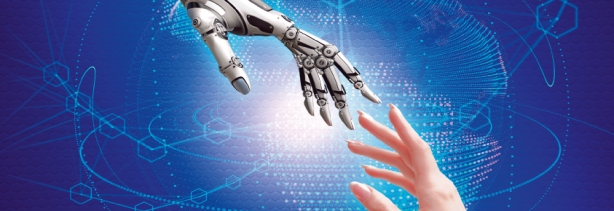
Like all industries the public sector is part of a world that is changing rapidly. Technology is connecting people within and across national boundaries and disrupting existing assumptions. Technology is one of the global megatrends that can be identified that will shape the role of governments into 2030 and beyond. An interview with Deborah Hofland about how technology will impact governments and the relation with citizens and businesses.
Information technology (IT) has transformed society over the last decades. IT not only ushered in the information age, but IT-based technologies have also been instrumental in enabling the research into development and growth of technologies in other fields such as applied science, health and transport. Technology is now creating novel opportunities, while testing the ability of governments to harness their benefits and provide prudent oversight.
The exponential growth in the volume and speed of access to information and communication has numerous effects. A list containing some facts:
- Of all the digital data in the world today the majority was created in the last two years.
- 59% of Europeans can access 4G, dropping to 15% in rural areas.
- 72% of Internet users still worry that they are being asked for too much personal data online.
- Denmark, Sweden, the Netherlands and Finland are the highest performing countries according to the Digital Economy and Society Index (DESI). They are not only ahead in the EU, but are the world leaders in digital.
- Already, cyber attacks account for $300 billion to $1 trillion in global losses.
What technology trends do we see in developments in the public sector?
A major focal point on the digital agenda of governments besides infrastructure is data, open data. Some evidence shows that by fully exploiting public sector data, governments could reduce their administrative costs. These estimates do not include the additional benefits that would arise from greater access to and more effective use of public-sector information. Such benefits can be obtained from weather forecasts, traffic management, crime statistics, improved transparency of government functions (e.g. procurement) and educational and cultural knowledge for the wider population. Another driver of change in this cluster is, of course, Big Data. Predictive analytics enables proposed policy changes in one system to be mapped against their flow-on impact to all systems. As a result we can have, and in some cases already have, deep insights into the trade-off between public policies regarding other major mega trends like water, energy, air and climate. At a local level there is more insight as well. Fire departments use advanced analytics to evaluate risk of fire in different places and manage their inspections accordingly. Police services use advanced models to predict where certain types of crime are likely to happen under certain conditions. Automated advanced models to support risk based inspections and supervision to support supervisory bodies are available and integrated in the rule and workflow based systems. The digitization also presents a significant new type of risk in the form of cyber security challenges. Governments already face pressure to protect their citizens, their own operations and the security of their nations from threats not seen before. This will increase even more. The European Union Institute for Security Studies predicts that “over the next two decades, the cyber sphere is likely to become an arena of conflict and tension between states of all political stripes, not least among those for which cyber security is a key component of intelligence and military strategy, and also between individuals or private companies.”
It can’t just be all about data?
Besides the fact that the constant improvement and evolution of technology creates enormous opportunities for improved efficiency and improved decision making for governments I also see other opportunities now lining up. The integration of new technologies into the lives of people and businesses offers governments the challenge to reinvent the way public administrations communicate with both citizens and businesses. It offers opportunities for more collaborative and participatory relationships and challenges to actively shape political priorities, collaborate in the design of public services and participate in their delivery. The design of the new services models in thriving on collaboration are becoming more and more a reality. Collaboration with citizens and users plays an increasing role in the transformation of public services towards new forms of production and delivery. IT-enabled collaborative service production refers to any public service that is electronically provided by government, citizens, NGOs, private companies and individual civil servants, whether or not in collaboration with government institutions, based on government or citizens-generated data. While the public sector does have in most situations the prime role in ensuring that public value is created, its potential to do so is enhanced through cooperation with others. Acting as an open participation and collaboration platform, making data and information accessible, government can support an ecosystem of actors, both interacting organizations and individuals, thereby generating public value.
Smart or maybe smarter cities are becoming more and more a reality. As a concept of course it goes beyond merely the use of IT. It is about smarter urban transport networks, upgraded water supplies and waste disposal facilities and more efficient ways to light and heat buildings. And it also encompasses a more interactive and responsive city administration, safer public spaces and meeting the needs of an ageing population. I think the main question is in what order the concept will be achieved.
Do you think the time is right?
The boundary between what is considered public and what is considered private is blurring. The digital revolution has created a new generation of people who want ever more accessible, portable, flexible and customized products, services and experiences. They expect to move seamlessly, in real time, between the physical and virtual worlds and they are prepared to disclose quite a lot about themselves to achieve their desires. This of course demands acknowledgement of reinvented views on how to more effectively protect privacy and the realization of the economic and social benefits of trustworthy and innovative uses of personal data. As cross-border flows of data continue to increase, privacy protection regimes need to support open, secure, reliable and efficient data flows, while lessening privacy risks and enhancing responsible behavior in the use of personal data. I think the new generation will be “digital natives” that are intimately familiar with digital technologies. Along with all the investments being done for educating people across all generations to have digital skills, we will be able to make the next step.
Where will these developments lead to in a few decades?
We don’t need a Back to the Future: The Sequel to predict that ordinary citizens will use technology to let their voices be heard and challenge government leaders about their ability and willingness to address public concerns and requests. But if we do make a Back to the Future: The Sequel, it will show that governments will be connected, networked and fully joined-up and will interact with each other and with private actors. The services provided will be personalized, allowing users to design and create. Data and public sector information will be provided 24/7 and responsibly. Modular and re-usable public services are in place. The infrastructure and organization level that is required to adapt and continuously evolve to create value will be provided by innovative, agile and tech-enabled organizations that remain relevant by being responsive to rapidly changing conditions and citizens’ expectations.
In one of the scenes in Back to the Future: The Sequel, Dr. Emmett Brown (“Doc”) will refer to George Orwell’s Big Brother and Marty McFly’s smart robot is the only one who will understand the joke. Marty gets in his smart, green and integrated means of transport while getting a license of some sort within 2 seconds – a piece of data that is analyzed for public policy evaluation. Three seconds later this data will be used for a crowd funding initiative. And for those who remember and loved the DeLorean: the means of transportation is as cool as the DeLorean but is of course a public service, so we can all use it.
Deborah Hofland is an associate director at KPMG Management Consulting. She has been working in the public sector for over 20 years and is involved in IT consulting for a variety of government bodies.




